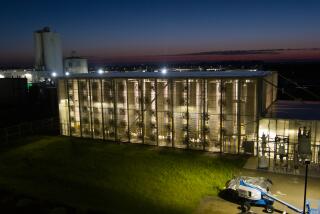Satellite Energy System Devised : Italians Seen Likely to Participate in ‘Star Wars’
TURIN, Italy — Working in a “clean room” the size of an aircraft hangar, Italian aerospace engineers have devised what they believe will be the source of at least some of the electrical energy needed to power the satellites and space weapons envisioned for President Reagan’s “Star Wars” defense system.
Aeritalia, the aerospace firm that conceived the energy device and is developing it, calls it a tethered satellite. It is a 1,000-pound sphere designed to be suspended from the U.S. space shuttle on a 60-mile-length of wire.
Ernesto Vallerani, general manager of Aeritalia’s Space Systems Group, says that as the satellite’s wire passes through the earth’s magnetic field it will generate electrical energy, which can be stored.
The satellite, which can be reeled in and out by its wire cable, is to be tested soon. Vallerani said it could also be trailed along in the upper reaches of the earth’s atmosphere, where increasing air density would reduce the shuttle’s orbital speed. There, he said, it could be used for a number of purposes, including lower-altitude observation for “Star Wars” warning and missile-tracking systems and for testing new atmospheric re-entry materials and designs.
Aeritalia’s tethered satellite is but one of many Italian schemes now under development that industrial companies involved in electronics and aerospace here expect to win them at least a small share of the $29 billion that the United States plans to spend on “Star Wars”--the Strategic Defense Initiative, as it is more formally known.
Says Firm Is Ready
Fiat, the giant auto maker that has five subsidiary companies deeply involved in advanced technology, is also moving to capture a share of SDI. Fiat Chairman Giovanni Agnelli was quoted recently as saying his company is ready to go.
“Europe is out of most Pentagon programs, but this represents a major opportunity,” he said, noting that the program could have “colossal implications” for high-tech development in Europe.
Despite the equivocal stance Prime Minister Bettino Craxi has taken on “Star Wars,” Agnelli was quoted as saying his company had government approval “to go ahead with SDI.”
The company reportedly has sent a special representative to Washington to look after its interests in the competition for contracts.
Aeritalia, a government-owned aircraft, space and avionics company that has long subcontracted for U.S. aerospace companies and the National Aeronautics and Space Administration, expressed confidence that, despite the deeply controversial nature of SDI in other European countries, Craxi’s government will soon approve the Reagan program.
“All signs we are receiving from the government are in line with a positive response,” Aeritalia’s Vallerani said.
Neither Aeritalia nor Fiat appears to be worried about the response of their thousands of Communist employees, whose strikes in the 1970s almost brought Fiat to its knees.
“Five or six years ago, there would have been trouble,” said Alberto Nicollelo, a Fiat spokesman. “But most people recognize that it is very important to our country to develop this kind of research. People understand that it is not an offensive system, it’s a defensive system.”
Contacts both at the government and industrial level appear to have gone so far toward Italian participation that industry sources say it is too late to turn back. Some say that Craxi is banking on a statement of general European support from the recently revived seven-nation Western European Union, whose defense and foreign ministers are scheduled to meet in Rome in November, before he moves publicly to offer Italian government endorsement of SDI.
Recent Visit
The recent visit to Italy of a team of American SDI technical specialists further encouraged a number of Italian companies to draw up contract proposals. Among them are the computer-making Olivetti & Co., the Montedison chemicals group, the Italtel telecommunications company and a consortium of eight defense and electronics companies headed by the state-controlled Agusta helicopter company.
According to Vallerani, the team of American experts expressed special interest in his company’s tethered satellite and two other company proposals that he declined to describe.
“They asked for concrete proposals,” he said, adding that “the SDI people immediately recognized that an application of this nature (the power-generating tethered satellite) can be of extreme benefit to produce energy.”
Italy also was visited recently by Lt. Gen. James Abrahamson, director of the SDI project, who also appeared confident of Italian participation. “I think people understand what the true objective of this program is,” he told reporters at the U.S. Embassy in Rome. “We really need the best minds available everywhere in the free world to work on it.”
Think They’re Compatible
Although there is a possibility of conflict between SDI research and the French-sponsored all-European Eureka program to develop home-grown advanced technology, most of the Italian companies believe the two are compatible. Eureka was proposed by France, which has rejected government participation in SDI, as a way to develop European partnerships in high-tech ventures, but no concrete projects have been adopted.
“I believe both SDI and Eureka can be done, but we are going ahead with the U.S. program first because it is ready with financing, staff and will start soon,” Agnelli was quoted as saying in a recent interview.
More to Read
Sign up for Essential California
The most important California stories and recommendations in your inbox every morning.
You may occasionally receive promotional content from the Los Angeles Times.









